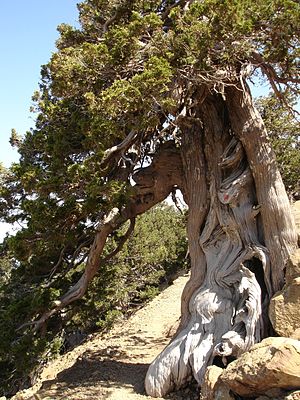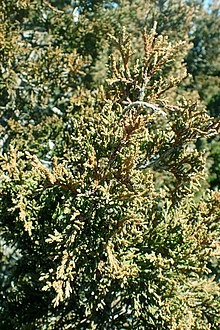Smelly juniper
| Smelly juniper | ||||||||||||
|---|---|---|---|---|---|---|---|---|---|---|---|---|

Smelly Juniper ( Juniperus foetidissima ) in the Troodos Mountains of Cyprus |
||||||||||||
| Systematics | ||||||||||||
|
||||||||||||
| Scientific name | ||||||||||||
| Juniperus foetidissima | ||||||||||||
| Willd. |
The Stinking juniper ( Juniperus foetidissima ) is a plant from the family of the cypress family (Cupressaceae). The crushed or crushed leaves have an unpleasant odor. It is mainly found in Southeastern Europe and in western Western Asia.
description
Vegetative characteristics
The stinking juniper usually grows as an evergreen tree with a straight, monopodial trunk and a diameter of 1 meter at chest height and with heights of up to 20 meters. Occasionally and often in regions of the tree line it also forms shrub or prostrate shrub forms. The first branches are irregularly spreading or ascending; the higher branches are spreading, short, thick and often curved. The crown of young trees is pyramidal in shape and in older specimens it forms an irregular, broadly conical habit .
The bark on young trees or twigs is smooth, but soon flakes off like paper. The light to light brown or gray and fibrous bark of older trees separates from the trunk in narrow strips. The irregularly arranged, dense, complex and upright, clearly square branches reach a diameter of 1 to 2 millimeters. Their bark is initially green, later reddish-brown in color and rough. They have bent back scales.
Both needle-shaped leaves and flaky leaves that run down and are crushed or ground and have a malodorous smell are formed. The needle-shaped, keeled and stinging leaves on juvenile trees as well as on the tips of older branches, arranged in threes in whorls , have dimensions of 5 to 8 millimeters × 1.5 to 2 millimeters. You only wear on the upper leaf surface stomata . The scale-like, rhombic to egg-shaped-rhombic, (wrong) -lanceolate and entire-margined leaves are up to 5 millimeters long on the older branches and 1.5 to 3 millimeters long on the outer branches. The scale leaves are arranged overlapping, pressed against the trunk or the tips bent backwards and have stomata on both sides of the leaf, which extend in two green or yellowish-green colored rows from the base to the tip. The sometimes brownish resin glands are usually absent or usually inconspicuous and inactive.
Generative characteristics
The stinking juniper is single- sexed ( monoecious ) as well as dioecious ( dioecious ). The flowering period extends from March to April.
The numerous, single and terminal or almost terminal, egg-shaped to spherical pollen cones are 2 to 3 (rarely up to 3.5) millimeters long and light yellow to yellowish-brown in color. They have eight to twelve microsporophylls with shield-shaped, rounded, thin, hyaline and often eroded edges and with four relatively large pollen sacs.
The numerous, single and axillary or terminally standing, seated or provided with 3 to 4 millimeter long inflorescence axes bear tiny cone scales. In the juvenile stage, they are flattened, elliptical in shape and frosted, with six distinct tips, 2 to 3 millimeters in diameter and bluish green in color. The spherical cones, fully ripe after two years, have a diameter of 5 to 13 millimeters and a dark reddish-brown to dark blue or almost black color. A cone contains one or two, rarely three seeds that are more or less fused and look like a single one. The light brown seeds are ovate-spherical or almost spherical with a diameter of 5 to 7 millimeters.
Occurrence
The distribution area of the stinking juniper ranges from the mountains of the Balkan Peninsula in Albania and North Macedonia southwards via Greece , further over the peripheral areas of Turkey to the southeastern regions of the Caucasus Mountains to Lebanon and northwestern Iran. There are isolated occurrences in Cyprus , Lebanon and along the northeast coast of the Black Sea near Novorossiysk and the Crimean peninsula . It thrives at altitudes from near sea level on the Black Sea to around 2000 meters in Anatolia .
The smelly juniper occurs mainly on dry, stony rock slopes and is associated with Cilician fir , Lebanon cedar , Mediterranean cypress , black pine , Greek juniper , Syrian juniper , Juniperus deltoides and Kermes oak .
Hazards and protective measures
The smelly juniper is common, reproduces independently and therefore does not appear to be endangered. Although it is included in the Red List of Threatened Species by the International Union for Conservation of Nature ( IUCN ), it is designated as “Least Concern”. A reassessment based on current data is considered necessary.
With the Fauna-Flora-Habitat Directive No. 92/43 / EEC in the updated version of January 1, 2007 (FFH-RL) Annex 1 of the European Union , protected areas are designated for habitat types in which juniper occurs - including those that smell Juniper - required.
Systematics
The stinking juniper ( Juniperus foetidissima ) belongs to the section or sub-genus Sabina in the genus Juniperus within the family of the cypress plants (Cupressaceae). It was first published in 1806 by Carl Ludwig Willdenow . As synonyms for Juniperus foetidissima Willd. are among others Juniperus phoenicea Pall. non L. , Juniperus sabina Sm. non L. and Juniperus sabinoides Griseb. cited.
swell
literature
- Robert P. Adams: Junipers of the World: The genus Juniperus . 2nd Edition. Trafford Publishing Co., Vancouver 2008, ISBN 978-1-4251-6880-3 , pp. 85, 186-187 .
Web links
- Christopher J. Earle: Juniperus foetidissima. In: The Gymnosperm Database. Retrieved May 23, 2011 .
- RPAdams: The Juniperus of the World / Taxa of Juniperus. Retrieved May 26, 2011 .
Individual evidence
- ↑ Rafaël Govaerts (ed.): Juniperus. In: World Checklist of Selected Plant Families (WCSP) - The Board of Trustees of the Royal Botanic Gardens, Kew . Retrieved March 28, 2019.
- ↑ Juniperus foetidissima in the IUCN Red List of Threatened Species 2010.4. Listed by: Conifer Specialist Group, 1998. Retrieved May 26, 2011.
- ↑ Council Directive 92/43 / EEC of May 21, 1992 on the conservation of natural habitats and of wild animals and plants in the consolidated version of January 1, 2007 , accessed on May 26, 2011 , p. 19.
- ^ Carl Ludwig Willdenow: Caroli a Linné Species plantarum: exhibentes plantas rite cognitas, ad genera relatas, cum differentiis specificis, nominibus trivialibus, synonymis selectis, locis natalibus, secundum systema sexuale digestas . 4th edition. tape 4 , no. 2 . GC Nauk, Berlin 1806, p. 853 ( online ).

